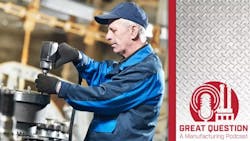Podcast: Technology's role in closing the skills gap
Anthony Offredi’s career has spanned more than 25 years, and he’s held leadership positions at Amazon, Ford, and Jeep. Now director of the customer solutions team at Quickbase, he has led multiple digital transformations at Fortune 500 manufacturing and logistics corporations across the country.
He recently spoke with IndustryWeek’s editor in chief, Robert Schoenberger, about how technology is facilitating the transfer of industry knowledge from one generation to the next. Schoenberger also supervises Smart Industry.
Below is an excerpt from the podcast:
Robert Schoenberger: Anthony, why is brain drain such a big problem today?
Anthony Offredi: Brain drain is a huge, huge problem for the industry. The veterans, the people that have 30 years or more experience inside of the manufacturing facilities, are retiring out. The big silver tsunami, as we've heard before. What's happening, and what really was the challenge during COVID, is that they never had the time to take the tribal knowledge that typically is within all of those veterans that have now retired out and then pass that along over to a new workforce.
See also: IT/OT convergence needs a human-centered approach
And that period of time, that just happened to be, because manufacturing happens in cycles, it just happened to fall during the COVID years. And a lot of that tribal knowledge never got transferred over. So it's a huge problem. A lot of the companies never had anything written down because they were just relying on, “Hey, Bob knew how to do it. Just go talk to Bob, and Bob will take you through the operator instruction sheet and train you on that job.” And now that's no longer available because Bob's in Florida enjoying life.
RS: It's interesting because there's been this demographic shift that happened in manufacturing before that. When you look at why there are so few, for instance, Gen. Xers in manufacturing when there were so many boomers, and it was because manufacturing employment was shrinking when a lot of the people who are now in their 40s and 50s were entering the workforce. So, it kind of skipped Gen. X, and you're going almost directly from the boomers to millennials and people like that, exacerbating that problem. You're not even just passing it off from people with a little bit of experience.
Study: N. American manufacturers drive 27% surge in AI adoption since 2022
AO: 100% correct. I happen to be one of the few Gen. Xers that managed a career, and I’m very, very happy in my career, but that's because I was brought up in manufacturing. I was rebuilding machines on my dad's factory floor when I started at the age of 12. Well, we won't talk about how young I was, but with small businesses, family businesses, you get brought up along with that. But you're right, it kind of skipped over, because during that period of time, we had a lot of people, a lot of companies, that were offshoring. Now it's all coming back onshore. Great. It’s a very, very good opportunity for new people to get involved in manufacturing, but it skipped over the Gen. Xers quite a bit.
And now we're going right into millennials and the Gen. Zers and it’s a completely different workplace, completely different transition than what a millennial is used to, going from a mobile-first technology into a technology that the baby boomers really had set up inside of manufacturing. And that is part of the problem as well. When you look at some sort of generational shifts, that's a large gap, very large gap, between the two.
See also: Crucial role of cybersecurity protection for PLCs
RS: So, what can technology do to help them? You're with a technology provider. What role can that play in recapturing some of that tribal knowledge?
AO: That's a really interesting question, and it's one that I fought with from the beginning, many years, while I was on the manufacturing floor. The biggest thing that technology can do at this point in time is just look at all the systems that are out there. The company that I work for now, Quickbase, really allows you to write your own programs and to write your own applications. And that's what millennials really are interested in, not being tied, tethered, to a 1993 spreadsheet, writing Excel formulas.
See also: Episode 3 of (R)Evolutionizing Manufacturing: All About AI
Don't get me wrong, they're fully capable of getting all that taken care of, and they understand Excel. It's just that they understand how inefficient that is, and what technology can do at this point is really adopt the mobile-first outlook that the millennials have because it's a better way. You can get the edge computing that a lot of folks are pushing for at this point in time, the millennials are going to bring that natively. And that is where I see technology can help out quite a bit. And with manufacturing, it's going to be transformational.
RS: We've seen a lot of examples of that the past few years, of using really good systems just to monitor what those 30-plus-year employees have been doing, capturing all the things that they just do automatically without thinking about it, without recording it, because that's what they were taught 30 years ago. And it's just part of their daily routine. So that's easy to lose.
AO: Exactly. Toyota does a great job with this. And at Amazon, obviously, a lot of the bigger OEMs do a great job with writing down standard work because, number one, you get paid on standard work. You don't get paid on odd work instructions. You have a set process that you have to follow, and if you have a set process that you can follow, then quality follows along with it. Now that's great because those operator instruction sheets are there, but the person that has been doing it for 30 years can pick up on the nuances of that standard work, can pick up on quality aspects of a part that they've been handling the last 20 years. They understand what the attributes are, what the quality needs to be.
See also: How AI can eliminate plant tasks people despise
When you try to pass that on to another person, it's very, very difficult if you don't have that interface happening in the work cell at the same point in time. So what technology is bringing along is that they're bringing along pictures, they're bringing along those operator instruction sheets, and they're showing you what a good versus bad part is. They're bringing that knowledge that used to be retained inside of these veterans, and they're bringing that knowledge inside of your phone. And it's right there at the worksite, and it's able to tell you a good part from a bad part, whether or not the process was done completely, and that's the stuff that you really need to have at the edge.
About the Podcast
Great Question: A Manufacturing Podcast offers news and information for the people who make, store, and move things and those who manage and maintain the facilities where that work gets done. Manufacturers from chemical producers to automakers to machine shops can listen for critical insights into the technologies, economic conditions, and best practices that can influence how to best run facilities to reach operational excellence.
About the Author
Robert Schoenberger
Editor-in-Chief
Editor-in-Chief
LinkedIn: linkedin.com/in/robert-schoenberger-4326b810
Twitter: @Rschoenb
Bio: Robert Schoenberger has been writing about manufacturing technology in one form or another since the late 1990s. He began his career in newspapers in South Texas and has worked for The Clarion-Ledger in Jackson, Mississippi; The Courier-Journal in Louisville, Kentucky; and The Plain Dealer in Cleveland where he spent more than six years as the automotive reporter. In 2013, he launched Today's Motor Vehicles, a magazine focusing on design and manufacturing topics within the automotive and commercial truck worlds. He joined IndustryWeek in late 2021 and took on responsibility for Smart Industry in 2023.

